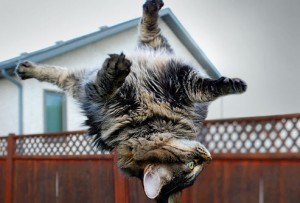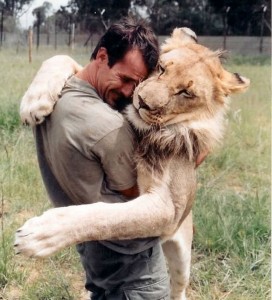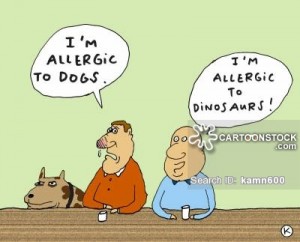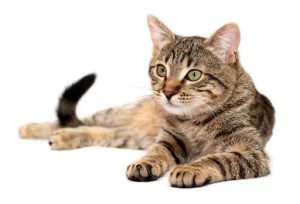This video is something I watched when I was studying animal behavior back in high school. The video displays two Capuchin Monkeys, both being fed a different food. The monkey on the left is given cucumber, while the monkey on the right is given grapes. As the video progresses you begin to see a sense of jealousy develop in the monkey on the left. He hits his hands against the floor, shakes the cage, and throws his food back our of his cage. The questions raised by this video address the implications of emotions we generally assume to be human. Mating in nature exists and causes conflicts, based on primal urges and physical instincts, but this example displays a sense of true jealousy. He wants what he cannot have and that in turn angers the monkey, causing him to physically display his distress. It gets you wondering, if monkeys can conceive of ideas such as desire based on observation, what other instances is this mechanism evidenced in? Besides all of the interesting thoughts that this video raises, it’s also a human controlled environment, and has artificial influence. In nature I wonder if this same scenario would unfold, or does the human interaction drive this animistic representation of “jealousy.”
Month: September 2014 (Page 1 of 4)
Thought you might be interested in this image which I spotted on the Facebook page for PA Bacon Fest (which will take place here in Easton on November 8-9).
 What do you notice now about this image’s directly stated vs. its implied messages?
What do you notice now about this image’s directly stated vs. its implied messages?

![]() The first thing that came to my mind when thinking of a picture of an animal was Tony the Tiger. I will be drawing on Berger’s notion of humans anthropomorphization and viewing tigers as “Tiger”. Tony the Tiger is the 100% fictitious “front-man” for General Mills’ cereal Frosted Flakes, but the message he sends to kids and the comparisons I see between what he represents and Berger’s whole idea of animals of the mind, happens to be anything but fictitious.
The first thing that came to my mind when thinking of a picture of an animal was Tony the Tiger. I will be drawing on Berger’s notion of humans anthropomorphization and viewing tigers as “Tiger”. Tony the Tiger is the 100% fictitious “front-man” for General Mills’ cereal Frosted Flakes, but the message he sends to kids and the comparisons I see between what he represents and Berger’s whole idea of animals of the mind, happens to be anything but fictitious.
In this picture, Tony wears an embroidered ascot, has a very fit physique and a grin ear to ear. Everything about this image screams friendly, approachable character.
Every kid knows Tony the Tiger, and his catchphrase “they’reeeee greattttt!” Before reading Berger, I had thought of Tony to be just a funny, happy-go-lucky cartoon character. I venture to say, not only is Tony’s anthropomorphization from Berger’s notion of “Tiger” to something less animalistic is peculiar, it is a sign of the collapse on how humans look at animals.
All cereal brands use a mascot of sorts to reach out to kids. How does Tony the Tiger reach out to kids so well? The Tiger represents a fierce animal, every kid aged toddler and above knows what a Tiger is. The Tiger is one of the staples at zoos. Frosted Flakes could not use a natural Tiger as their mascot, that would turn kids off and scare them. They turned a fierce animal into an enthusiastic, baseball-playing, father-like figure. A Tiger, as a father-like figure.
Before Berger, I viewed this image as a friendly, unthreatening, fictitious being. Berger talked a lot about “animals of the mind.” Animals have been thrown out of their category as animal and thrown into categories such as families and spectacles. Berger continues to compare all animals now “appear like fish seen through the plate glass of an aquarium,” never seen in their natural habitat, just in human’s vision of their ideal home. In my opinion, showing a tiger in its natural habitat would just as much draw kids in as Tony the Tiger. Berger was all about looking at animals as their primal origins defined them as. A Tiger is a hunter, and a fierce competitor; it should be viewed as such.
Berger would call out General Mills on promoting the trend that people seem to follow these days; the trend being the practice of using/viewing animals as useful beings, and looking at them as commodities. If Tony the Tiger was just a normal, fresh out of the jungle tiger, Berger would have no problem with that. It’s merely the fact that in today’s world a cereal company needs to turn him into a human being that Berger would dislike. In not even three weeks of this class, it has taught me to think about the animal in a more holistic way then I have previously. It is not so much my views have changed, as much as now I am thinking more about the animals in a different context.

Of all the animal subjects of human anthropomorphism, cats are among some of the most blatantly personified. We see in cats a human sassy-ness and individuality that isn’t really obvious in too many other day to day creatures, as dogs, for example, seem to possess qualities more along the lines of eagerness to please and loyalty to group or a family. While there are certainly instances in which cats are stripped of what Alice Walker might choose call their “catness,” there are also moments in which they are portrayed almost unintentionally equally to humans, but in a distinctly cat-ish way. The example that I would like to use is one of many animal videos on youtube labeled “Funny cat compilation” https://www.youtube.com/watch?v=BmnyORo_slM. Give it a quick watch.
At a first glance, this could seem to many as a demeaning representation of cats. These cats are doing things that are downright stupid for the most part. Pouncing on things that aren’t alive, trying to play a guitar, etc. With the wrong point of view, it could seem as though the objective of this video was to further hoist ourselves as humans onto an even higher pedestal than the one we already seem to occupy above animals. I would argue, however, that this video is in many respects one of the truest examples of a human appreciation of cats for exactly the animals that they are, just expressed in the context of a human habitat.
The age old characteristics of cats that we have objectively known to be true, such as curiosity, physical balance, and slyness are seen to fail in some way. Yet, in spite of this failure, what is really happening when we choose to laugh at videos such as these is a deep appreciation for an animal that we have dared to consider one of our greatest companions as a race over the years. Without really bestowing our own characteristics on the cat, we watch it try and fail to do cat things. There really is a whole lot of good in what I would call a symbiotic relationship between humans and domesticated pets. I would go as far as to say it’s a pretty beautiful thing at times. However naive that may seem, I wasn’t feeling cynical today.
Hello everyone, I’m Brian O’Neill and I’m a Junior from Wayland, Massachusetts. I’m a film and media studies major with Spanish minor, and I also write for The Lafayette sports section. Writing has always been my favorite academic activity at school considering I’m god awful at math and wouldn’t last 30 seconds as any major that required computing of any sort. So here I am, doing my best to represent animals with the rest of you!
As for my relationship with animals, well, let’s just say that I’ve always wanted a dog, and probably would have one if not for a set of crippling factors. I myself am allergic to dogs, and cats, and some other fluffy or furry animals with dander of some sort, including (but not limited to) horses and donkeys and what not. My allergy to cats is much worse than my allergy to dogs, and the outcome of being too close to a cat can end with a few frantic inhaler hits and an eye drop in each eye. My issue with dogs is much more subtle, but all the more frustrating. It would seem for a time that being near a dog, or even just in the same house as a dog, is fine, and often times I’m led into a false sense of security thinking that I’m safe from the impending misery that will soon catch up to me. This doesn’t even come close to stopping me from playing with dogs though – I will always give a happy puppy a treat and a head scratch and just deal with the consequences. As a matter of fact, I frequent videos such as these https://www.youtube.com/watch?v=NY9Vs7dnQPM in order to explore my hypoallergenic options.
Beyond animals, I am a huge sports fan, and I adamantly follow both Soccer and Football. I write for the Men’s Soccer team here at Lafayette.
As you can see I choose the image of a human-tiger encounter, at what seems to be some sort of circus. The first thing I noticed was that the human who is most likely the tamer is giving the tiger a kiss. To our knowledge what’s typically known as a ferocious and dangerous animal, the tiger is accepting the kiss without any hesitation. Both the human and tiger appear to be reaching out for the peaceful gesture. This isn’t how a tiger would act in the wild, which makes sense that my next observations of the picture told me what it did. There is a black cage surrounding the two, with a blackened background, but a spotlight being shined onto the two. Clearly this is a circus and the tiger has been trained to preform at the humans command. The last thing I recognized as I closely examined the photo was the whip behind the humans back. The tiger is trained well enough to kiss the human but there is still a form of superiority represented by the whip. It may also serve as a division between the two species.
sort of circus. The first thing I noticed was that the human who is most likely the tamer is giving the tiger a kiss. To our knowledge what’s typically known as a ferocious and dangerous animal, the tiger is accepting the kiss without any hesitation. Both the human and tiger appear to be reaching out for the peaceful gesture. This isn’t how a tiger would act in the wild, which makes sense that my next observations of the picture told me what it did. There is a black cage surrounding the two, with a blackened background, but a spotlight being shined onto the two. Clearly this is a circus and the tiger has been trained to preform at the humans command. The last thing I recognized as I closely examined the photo was the whip behind the humans back. The tiger is trained well enough to kiss the human but there is still a form of superiority represented by the whip. It may also serve as a division between the two species.
Before reading John Berger’s “Why Look at Animals?” I would have viewed this image as harmless. It seems like there is a good relationship between the human and the tiger. The tiger must like the human enough to share a kiss with him. I also wouldn’t have seen the wrong doing to the species of Tigers in performances like such. I would have deemed this circus as entertaining for majority of humans before reading Berger.
Now that I have read Berger’s essay, I can say that images like this one is not all that meets the eye when we look at interesting animals like the Tiger. I don’t agree that humans should be putting animals of any species in zoos or circuses. It is only hurting the species. Berger’s essay tells us the vast history of human and animal relationships. As you may or may not know, tigers are an endangered species. Humans have felt the need to use Tigers for several different reasons, and barely any are to the species benefit. According to Berger “The commercial exploitation of certain species (bison, tigers, reindeer) has rendered them almost extinct. Such wild life as remains is increasingly confined to nation parks and game reserves” (p. 13). If we care about tigers or any commercialized animals we find so much interest in, we must not interfere with their ways of living, because they won’t be around much longer for us to admire.
Sources for post:
Berger, John. “Why Look At Animals?” About Looking. New York: Pantheon, 1980. Print.
“Dragons Circus Review.” The Peanuts Gang. Web. 22 Sept. 2014
I recently attended a talk given by artist Micheal Pestel. Pestel’s work is based largely on appreciating the birds in our lives that we often take for granted. His work also carries messages about the problems of bird extinction and how humans have a diminished relationship with nature. In his talk, Pestel discussed how birds helped him combine his love of music and art. He said that “to you they are birds, but to me they are voices in the forest.” By stating this, he was trying to show that he had a strong relationship with birds. By referring to them as voices, they were no longer considered animals and thus no longer considered second-class citizens of the Earth. He then emulated their voices by using several different flutes to make bird sounds.
Pestel’s views often align with Berger’s. For example, Pestel mentioned in his talk that three things killed the passenger pigeon: the locomotive, the telegraph, and the gun. He stated that these man-made inventions will now forever carry the shadow of causing a mass extinction. Berger showed a similar disdain for the Industrial Revolution and its consequences in his novel About Looking when he wrote that “the 19th century, in western Europe and North America, saw the beginning of a process, today being completed by 20th century corporate capitalism, by which every tradition which has previously mediated between man and nature was broken” (3). Pestel mentioned that we stopped treating the world as our tribal ancestors did and believes that we have lost our relationship with nature because of the printed word. He thinks that we can regain the lost voices of animals by transforming our own language and own experience. He calls this “listening in with our mouths.” Although Pestel did not mention any specific ways that we can transform our language to help us understand animals more, one way that I think we can do so is by eliminating the human/animal binary from our language. We can do this by not lumping all non-human animals into the one category “animal” because this categorization promotes a view of self vs. other in which one must be inherently superior as opposed to viewing other creatures as equals living together harmoniously on Earth.
References:
Berger, John. About Looking. New York: Pantheon, 1980. Print.
Pestel, Michael. “Brown Bag Artist’s talk: Michael Pestel: Requiem, Ectopistes, Migratorius.” Lafayette College. Williams Center of the Arts, Easton, PA. 17 Sept. 2014. Guest Lecture.
My name is Christopher. I live in a small beach town in New Jersey with my two sisters and mom. I also have two cats that my family adopted from a summer camp and have had more pet fish than I can count. I am a member of the Lafayette Ice hockey team and therefore spend a lot of my time either practicing or playing, but when I’m not on the ice I enjoy film making and watching English Premiere League Soccer.
At Lafayette I am a Film and Media Studies major and hope to one day be a screenwriter/director for half hour variety shows like The Tonight Show with Jimmy Fallon. I think that working in the television industry would be incredibly rewarding because as a filmmaker you have the power to create stories that can bring joy to others, which is a perk that very few jobs have.
Apart from filmmaking, my other passions include outdoor activities like wake boarding, fishing, and sailing. My favorite places to do these activities is Lake Placid, New York, which many know as the site of the 1980 Miracle on Ice Olympic Hockey game. My family owns a house there and we spend a great deal of time every summer in this Adirondack getaway. One of the reasons I like Lake Placid is that it has an abundances of mountains, lakes, and wilderness so there is something to all year around.
By taking this class I am hoping to improve my writing skills and learn more about how we as a society value animals.
Another interesting animal controversy in the news:
The studies, which began in 2007, attempt to model some of the environmental risk factors associated with human mental illness, such as parental neglect and childhood abuse or
trauma, in an effort to understand how they interact with genetic factors.
Methodologies used in the studies included separating baby monkeys from their mothers shortly after birth; sedating a mother in the baby’s presence to see how it responds when she loses consciousness; intentionally startling monkeys with sudden, loud noises; and subjecting the monkeys to invasive procedures such as spinal taps and intracranial administration of medications.
The King of the jungle, and a human. A relationship a human shares with a lion is vastly rarer than that of a horse or a dog. Lions are cats, large cats with incredibly strong jaws and hunting prowess, but at the core, still a cat. Animals that were once powerful and primal hunters, have now become the many breeds we see today in species such as cats and dogs. The image shows a man kissing and hugging a lion whom he considers to be a friend of his. The story is that this individual spent years researching and playing with the  lions, so they became familiarized with him and could recognize him. The embrace is oddly human as a hug is generally something we do when we love or care for another. A lion could bite a man twice and kill him, but the man trusts his relationship with the animal so much that he is defenseless and vulnerable. Species such as lions, panthers, wolves and other large predatory mammals are ancestors of the cute animals many of us call pets. It’s ironic to see species such as the Black Panther and Bengal Tiger nearing extinction as they are the remnant of a rich animal history that precede human existence. The saber-tooth tiger was more or less a larger lion with some tusks, but was a primary threat to early age men. Our discussions in class oftentimes force me to ponder how I look at my pets because it blows my mind that in a span of 2,000 years, we have domesticated and controlled a range of breeds and species to the point where many of us forget their evolutionary roots. Considering the teachings of Berger, applying the concept of dualism to animals is already putting ourselves above them in a sense. In areas such as Africa, large preserves and national parks have rare species in a large, but slightly maintained area of land. Natural selection and processes would injury these species, but humans would intervene to save them and tend to their injuries. At first consideration it doesn’t seem like a bad thing to do, but now factor in that these last few species are out of place.
lions, so they became familiarized with him and could recognize him. The embrace is oddly human as a hug is generally something we do when we love or care for another. A lion could bite a man twice and kill him, but the man trusts his relationship with the animal so much that he is defenseless and vulnerable. Species such as lions, panthers, wolves and other large predatory mammals are ancestors of the cute animals many of us call pets. It’s ironic to see species such as the Black Panther and Bengal Tiger nearing extinction as they are the remnant of a rich animal history that precede human existence. The saber-tooth tiger was more or less a larger lion with some tusks, but was a primary threat to early age men. Our discussions in class oftentimes force me to ponder how I look at my pets because it blows my mind that in a span of 2,000 years, we have domesticated and controlled a range of breeds and species to the point where many of us forget their evolutionary roots. Considering the teachings of Berger, applying the concept of dualism to animals is already putting ourselves above them in a sense. In areas such as Africa, large preserves and national parks have rare species in a large, but slightly maintained area of land. Natural selection and processes would injury these species, but humans would intervene to save them and tend to their injuries. At first consideration it doesn’t seem like a bad thing to do, but now factor in that these last few species are out of place.
The intrusion of man into these predators’ environments demonstrates that we cannot respect the boundary between man and nature at times. We recognize ourselves as individuals, and humans have a perception that supports the claim that humans are in our own eyes, superior. Whether it’s an anthropomorphism animals out of sympathy or miss-identifying lions as entertainment in zoos rather than hunting in the safari, humans are overly engrossed and invested in attempting to satisfy ourselves as more intelligent beings. Berger and Walker have advanced my knowledge of the multitude of perspectives on animals and our relationships, but I have been firm in my views prior to reading their work. Swimming with White Sharks and seeing them hunt from a young age solidified my desire to see nature as it should be, without human interaction. I knew that as I got older I would learn more about factors such as the economic benefits of animals and their instrumental value, but it often times is touch to gauge how I feel about my relationships with animals I encounter. Berger’s claim that our communication with animals is hindered by a lack of language, which is true. What about a hug from a lion? Where does that fall on a scale of physical representation of emotions? I don’t know exactly what is going through the lion’s mind, but it’s evident that it’s a personalized relationship between a man and a 500 pound cat. Other behavioral qualities of lions can be read at the following URL: Lion Behavioral Traits and Qualities.


Recent Comments